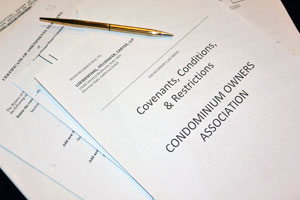LHC Newsletter , Volume 9, No. 5
“Tips for Dealing With Difficult People”
By: David A. Loewenthal, Esq.
Loewenthal, Hillshafer & Carter, LLP
Maybe it is me, maybe it is the world we live in, or maybe it is simply the new reality that general Board meetings are seemingly becoming more combative and hostile.
Most of us have attended a Board meeting where one or more members have disrupted a Board meeting, hijacked the meeting, shouted people down, used profanities, or threatened other members or the Board. It is not easy for a Board to combat this conduct since disruptive members are often threatening. Board members are understandably intimidated by such actions or outbursts.
In order to attempt to deal with this situation, there are several potential actions that the Board can take prior to, during and after a meeting, which are as follows:
At the outset, the agenda for the general meeting should specify when open forum will be conducted and how long each member has to speak (generally two to three minutes). Conducting the open forum at the beginning of the meeting allows the maximum number of members to participate whereas conducting the open session at the end of the meeting may decrease the number of members speaking since they may not stay until the end. A potential downside with having the open forum at the beginning of the meeting is that if one or more homeowners will not yield the floor after their time allotment or become hostile and disruptive it may cause the entire meeting to devolve, thus preventing the Board from actually conducting the business of the Association. Conducting the open forum at the end ostensibly allows the Board to end the meeting and walk out if one or more homeowners are still attempting to disrupt the meeting.
If, during the meeting, one or more members is disruptive, combative, threatening, will not yield the floor, etc. then, the Board would be within their power to require that the member leave the meeting. The member should be given ample warning; however, if a member refuses to cease their disruptive conduct, the Board is within their power to have them removed. It is important to note that you should not physically touch the disruptive member to avoid a claim of assault and battery. If the situation is truly getting out of control, then it may be appropriate to call local law enforcement. If a member is told to leave a meeting, as a result of their conduct, such conduct could become the subject of a disciplinary hearing pursuant to Civil Code Section 5855 and corresponding fines pursuant to the Association’s published fine policy.
Another option when a member is overly disruptive, is to move the meeting to a member’s private residence. Since it is a private residence, the member has the right to control who may enter their property. The problem with this option is that in a large Association it may be impractical to try to move an entire meeting into a member’s private home.
In those instances where one or more members are continuously disruptive, thus preventing the Board from conducting the meetings on an on-going basis, the Association may wish to consider obtaining a restraining order. A restraining order is an order obtained from the Court which protects the person who has obtained the restraining order from being threatened, attacked, harassed, etc. by another person who the restraining order is against. Examples of restraining orders include, but may not be limited to, restraining threatening phone calls, assault, harassment, yelling, etc. Pursuant to Code of Civil Procedure Section 527.8, an Association can seek a protective order for Board members, officers, community association managers as they are deemed to be “employees.”
Disruptive members often cite to their right to “free speech” as their basis to say whatever they want, for however long they want and wherever they want. That is simply not the case. Remember the old adage that “you can’t yell fire in a crowded movie theater.” Members do not have an unfettered right to act or say whatever they want under the guise of free speech.
The difficulty for the Board is balancing the right of the member to make comments, including dissenting opinions, versus when such conduct becomes overly disruptive. On the one hand, to the extent that a member is within their open forum time allotment, within limits, the Board does need to allow the owner to express their thoughts, comments, and opinions. Sometimes such comments come close to being defamatory. However, members do not have an unfettered right to make threats, scream obscenities, promote violence, etc. [A member can make statements that the Board is not doing a good job as well as accusing mismanagement by the community manager. (See Damon v. Ocean Hills)]
Interestingly, it is not only members whose conduct may become disruptive or problematic. Often Board members conduct themselves in a manner that brings their actions into question, such as when a Board member is acting in a way that is not necessarily in the best interest of the Association, but rather is in their own personal best interests. As an example, attempting to pressure or influence other directors to enter into contracts, when that Director has a financial interest, thus creating a conflict of interest. Members of the Board are fiduciaries and are required to exercise their powers in accordance with the duties imposed by the Corporations Code. This includes exercising due care and undivided loyalty to the Association. (Francis T. v. Village Green Owners Association).
Similar to individual members, a disruptive Board can negatively impact Board meetings which can prevent the meeting from proceeding forward, shutting down discussions, and possibly other Board members simply throwing up their hands and resigning from the Board. Unfortunately, a combative Board member’s goal is often to chase away good Board members.
A Board has a few options in dealing with a disruptive or rogue Board member, as follows:
A censure letter can be issued by legal counsel to the Director with a copy to the rest of the Board outlining in detail the offensive conduct and explaining why such conduct is inappropriate and unacceptable for any Director on the Board. Such a letter explains what the legal and fiduciary obligations of the Director are including demonstrating undivided loyalty to the corporate entity and to undertake no actions which could potentially expose the Association to risk or claims against it. Censure letters are confidential and should not be made public to the membership at large.
A censure letter should also discuss potential liability implications to the Association and the individual Director, including the possibility that if claims are asserted against the Director or Association, liability insurance may not cover the claim or provide a defense. Finally, the censure letter will advise the rogue Director of the consequences of not ceasing or correcting such behavior in the future. A censure letter could demand that the Director resign or be subject to public action to address their behavior.
The Board can make a decision to remove the disruptive/rogue Board member from holding a specific office, such as President, Secretary or Treasurer. It is important to note that this is different than attempting to remove a Board member from the Board. There are very limited circumstances that allow a Board majority to cause a Director’s removal from the Board itself, which are usually set forth in the Association’s Bylaws and generally limited to being convicted of a crime or being adjudged incompetent.
Pursuant to Corporations Code Sections 7222 and 7510(e) five (5) percent of the membership, can sign a petition calling for a special meeting of the membership for the purpose of recalling an individual Director from the Board. Associations which utilize cumulative voting must use a complicated formula to determine the requisite percentage necessary to remove a Director from the Board which can often make it difficult. A recall election is conducted in the same formal manner as any other election of Directors, with secret ballots opened at a noticed meeting by appointed election inspectors.
Finally, though it is rarely used, there is an ability to file a lawsuit to remove a Director pursuant to Corporations Code Section 7223. This generally involves filing a lawsuit to have the Court remove a Director based on conduct including dishonesty, fraudulent or gross abuse of authority or discretion. This option is rarely used because the Association cannot fund the cost of litigation, as the Association must be named as a defendant in such an action, meaning that the individuals must pay to prosecute this action.
Again, dealing with disruptive members and/or Board members is a difficult process; however, if not dealt with early on it can fester and become untenable for the Association as a whole.


